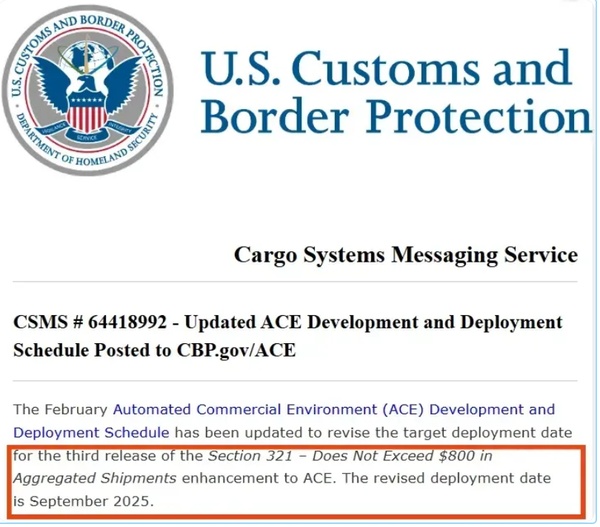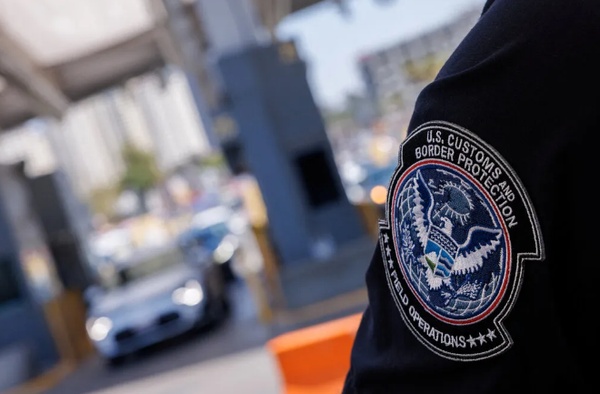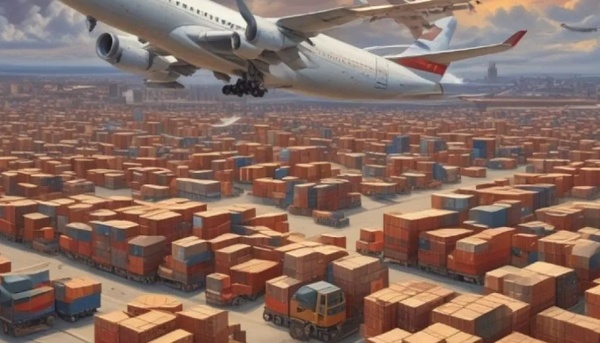Enjoy tariff exemptions before 9 months? US strictly investigates underreporting of goods and imposes heavy fines.

The U.S. Customs CSMS (Cargo Systems Messaging Service) has released a重磅公告 that has caused a stir in the cross-border e-commerce industry. The announcement focuses on the "Commercial Environment (ACE) Development and Deployment Program," and clearly sets key deployment milestones for September 2025. This news has immediately caught the attention of many practitioners, signaling a major upcoming transformation in the industry.
Recently,The inspection rate of U.S. Customs has soared to 70%.China's cross-border e-commerce has encountered a severe crackdown on "underreporting shipment values." Overnight, the "American Dream" of Chinese cross-border sellers was awakened by a surge in customs inspection rates.The inspection rate skyrocketed from 5% to 70%, causing a chain reaction of opening shipping containers, astronomical fines, logistics paralysis, and stockout crises for Chinese goods.
In terms of the declaration processThe addition of the "Estimated Arrival Time" field may seem like a minor adjustment, but it has a profound impact on the collaboration between logistics and customs clearance. Sellers must take this factor into account when arranging the transportation of goods to ensure smooth declaration.
Meanwhile,The U.S. Customs has also drawn a warning "red line."When the import amount per day or per person exceeds the $800 limit, the ACE system will immediately trigger an alert. This means that the previous space for sellers to engage in risky operations using the small import tax exemption has been significantly reduced. Once the warning is triggered, subsequent customs clearance processes will face stricter scrutiny.
In terms of compliance oversightThe ACE system has also undergone comprehensive upgrades. Even within the $800 duty-free exemption, Customs will strictly control non-compliant goods. Past practices that attempted to circumvent regulations will be completely ineffective. Only fully compliant merchandise will be able to pass smoothly.

A home furnishings seller in Ningbo had their container seized and received a $280,000 fine due to a 12% discrepancy between the declared cargo value and the actual purchase price. This fine was equivalent to one-third of their annual profit. Additionally, logistics timelines were disrupted, with inspection times extending from an average of 3 days to 21 days, and the out-of-stock rate at Amazon warehouses soared to 47%.The cost aspect has become even more challenging, with ordinary inspections taking 7-15 days and exceeding 30 days in total time, leading to a 30%-50% increase in logistics costs. Some sellers have exclaimed, "Logistics fees are higher than the value of the goods."
The "microscopic scrutiny" by U.S. Customs is triggering a chain reaction. Amazon sellers are facing life-and-death challenges, with stockouts causing their IPI scores to plummet and warehouse capacities being cut.The independent site has seen a "return wave," with logistics delays exceeding expectations and the return rate of consumers soaring by 20%, leading to a surge in operational costs.
Industry insiders point out thatAccording to the calculation based on a 70% inspection rate, a 28-day delay, and a 30% increase in logistics costs, the seller's overall costs will increase by more than 40%.The low-price strategy has completely failed, and profits have become extremely thin.

It is worth noting that while the development and deployment schedule for the ACE system has been updated to September 2025, officials have explicitly stated that this is a conceptual timeline and is subject to change at any time. This announcement has sparked heated discussions among the seller community. Some sellers are hopeful that the $800 exemption policy may be extended until September as a result, providing them with a temporary safe haven amidst the tumultuous trade winds. However, there are also voices of reason pointing out,The announcement did not directly state a direct connection with the "removal of the $800 duty-free threshold," so the 800-dollar exemption policy still faces the risk of cancellation.
Looking back, tariff storms have repeatedly battered the dyke of the cross-border e-commerce industry. From initial shock to panic over the future, and now to gradual calm, behind the scenes are the hardships and explorations of countless practitioners. Fortunately, the postponement of T86's cancellation has injected a shot of adrenaline into the industry. Many sellers are seizing time to prepare response strategies to cope with potential policy changes.

Veteran sellers in the industry suggest,Once T86 is ultimately canceled, relying on the customs clearance model of T01 and T11 through commercial express is a more reliable approach. At the same time, caution must be exercised when considering the seemingly "shortcut" method of bypassing customs through transit countries.In the battlefield of cross-border trade, only compliant operations can go further.
An experienced logistics expert candidly stated that...Chinese sellers are facing the daunting challenge of transitioning from the "duty-free advantage" comfort zone to the new normal of "full compliance and high-cost operations."The key strategy to cope with this transformation lies in implementing a compliance-oriented, diversified, and refined "three-dimensional development blueprint." Only by deeply embedding "compliance" into every aspect of business operations can Chinese sellers achieve the transition from pursuing short-term profits to stable long-term profitability.
【Copyright and Disclaimer】The above information is collected and organized by PlastMatch. The copyright belongs to the original author. This article is reprinted for the purpose of providing more information, and it does not imply that PlastMatch endorses the views expressed in the article or guarantees its accuracy. If there are any errors in the source attribution or if your legitimate rights have been infringed, please contact us, and we will promptly correct or remove the content. If other media, websites, or individuals use the aforementioned content, they must clearly indicate the original source and origin of the work and assume legal responsibility on their own.
Most Popular
-

List Released! Mexico Announces 50% Tariff On 1,371 China Product Categories
-

Nissan Cuts Production of New Leaf EV in Half Due to Battery Shortage
-

New Breakthrough in Domestic Adiponitrile! Observing the Rise of China's Nylon Industry Chain from Tianchen Qixiang's Production
-

Dow, Wanhua, Huntsman Intensively Raise Prices! Who Controls the Global MDI Prices?
-

Mexico officially imposes tariffs on 1,400 chinese products, with rates up to 50%






